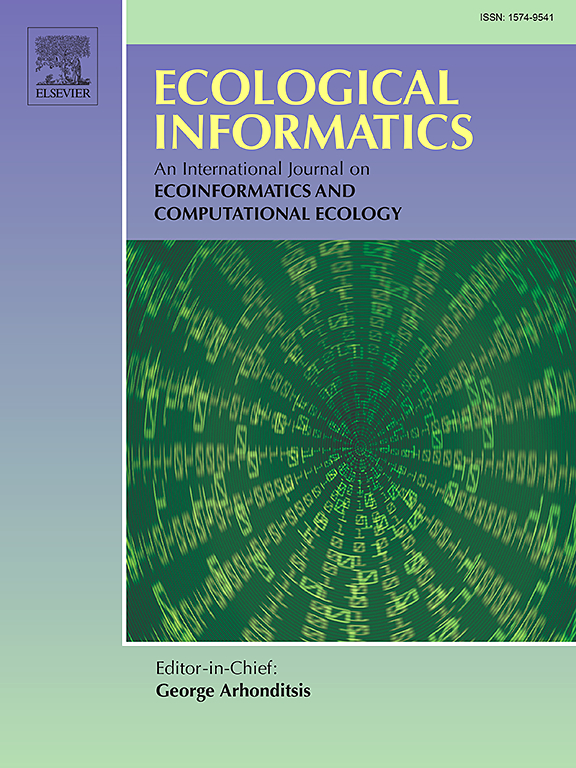HawkEars: A regional, high-performance avian acoustic classifier
IF 5.8
2区 环境科学与生态学
Q1 ECOLOGY
引用次数: 0
Abstract
Passive acoustic monitoring is rapidly emerging as a dominant approach for studying acoustic wildlife, with neural networks used as an increasingly common and promising approach for extracting detections of particular species from acoustic recordings. Existing options for avian classifiers include small custom models for focal species or large models that attempt to classify the entire global avian community, which suggests a possible tradeoff between classifier performance and species coverage. We argue that building domain-specific classifiers for particular geographic regions provides improved performance in exchange for reduced species coverage and present HawkEars, a regional avian classifier for Canada that includes 314 bird and 13 amphibian species. A major challenge in classifier development is the weak labeling of open access datasets. We developed a novel solution, using embedding-based search to efficiently generate strong labels. We evaluated HawkEars performance for bird species relative to two prominent avian community classifiers: BirdNET, and Perch for two datasets representing two applications: bird community surveys and studies of vocal activity rate. We found HawkEars had substantially higher performance across all metrics, detected on average two more species per recording minute in our community evaluation dataset, and had a recall of nearly twice Perch and four times BirdNET, given a precision of 0.9, for our vocal activity evaluation dataset. We suggest HawkEars provides better classification performance because a smaller species pool allows for more resources allocated per species to training and tuning and reduces the risk of class overlap, and our strong labeling method ensures high-quality training data. While our classifier, HawkEars, is a substantial improvement for practitioners studying acoustic wildlife in Canada and the northern United States, practitioners in other regions can use the HawkEars open-source code to build classifiers for other geographic regions. By continuing to improve deep-learning classification performance, HawkEars has the potential to substantially improve the efficiency and utility of passive acoustic monitoring studies.
鹰耳:一个区域,高性能的鸟类声学分类器
被动声学监测正迅速成为研究声学野生动物的主要方法,神经网络作为一种越来越普遍和有前途的方法,从声学记录中提取特定物种的检测。鸟类分类器的现有选择包括针对焦点物种的小型定制模型或试图对整个全球鸟类群落进行分类的大型模型,这表明分类器性能和物种覆盖之间可能存在权衡。我们认为,为特定地理区域构建特定领域分类器可以提高性能,以减少物种覆盖率,并提出了HawkEars,这是加拿大的区域鸟类分类器,包括314种鸟类和13种两栖动物。分类器开发中的一个主要挑战是开放存取数据集的弱标记。我们开发了一种新颖的解决方案,使用基于嵌入的搜索来有效地生成强标签。我们评估了HawkEars在两种鸟类群落分类器(BirdNET和Perch)上的表现,这些数据集代表了两种应用:鸟类群落调查和声音活动率研究。我们发现HawkEars在所有指标上的表现都要高得多,在我们的社区评估数据集中,每记录分钟平均检测到两个以上的物种,并且在我们的声音活动评估数据集中,召回率几乎是Perch的两倍和BirdNET的四倍,精度为0.9。我们认为HawkEars提供了更好的分类性能,因为较小的物种池允许为每个物种分配更多的资源用于训练和调优,降低了类重叠的风险,并且我们强大的标记方法确保了高质量的训练数据。虽然我们的分类器HawkEars对于加拿大和美国北部研究声学野生动物的从业者来说是一个实质性的改进,但其他地区的从业者可以使用HawkEars的开源代码来构建其他地理区域的分类器。通过不断提高深度学习分类性能,HawkEars有可能大幅提高被动声学监测研究的效率和效用。
本文章由计算机程序翻译,如有差异,请以英文原文为准。
求助全文
约1分钟内获得全文
求助全文
来源期刊

Ecological Informatics
环境科学-生态学
CiteScore
8.30
自引率
11.80%
发文量
346
审稿时长
46 days
期刊介绍:
The journal Ecological Informatics is devoted to the publication of high quality, peer-reviewed articles on all aspects of computational ecology, data science and biogeography. The scope of the journal takes into account the data-intensive nature of ecology, the growing capacity of information technology to access, harness and leverage complex data as well as the critical need for informing sustainable management in view of global environmental and climate change.
The nature of the journal is interdisciplinary at the crossover between ecology and informatics. It focuses on novel concepts and techniques for image- and genome-based monitoring and interpretation, sensor- and multimedia-based data acquisition, internet-based data archiving and sharing, data assimilation, modelling and prediction of ecological data.
 求助内容:
求助内容: 应助结果提醒方式:
应助结果提醒方式:


